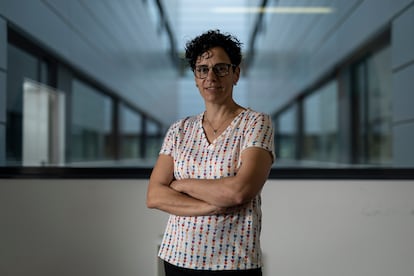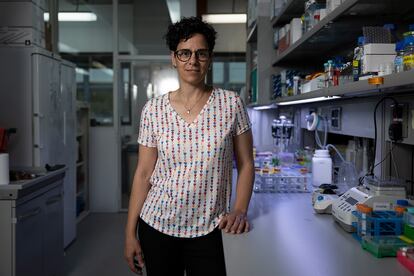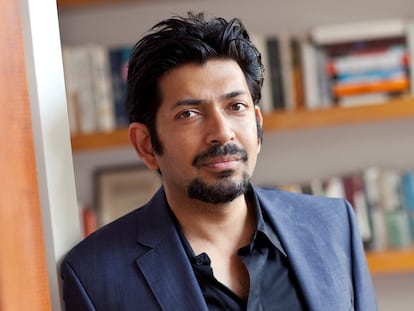Núria López-Bigas, biologist: ‘Healthy tissue also has mutations that lead to cancer’
The scientist and bioinformatics experts at the Biomedical Research Institute of Barcelona analyzes the genomic sequence of tumors to find the gene mutations that cause them

The biologist Núria López-Bigas (Monistrol de Montserrat, Barcelona, 47 years old) works with data, thousands and thousands of pieces of it. In her laboratory, the scientist, who is an ICREA research professor at the Barcelona Biomedical Research Institute and an expert in bioinformatics, genetically sequences tumors and dissects the information with powerful artificial intelligence (AI) tools. The data may contain the answer as to why a cell goes out of control to create a cancer and what gene mutations are precursors of a tumor. “We help to digest all this information efficiently to give a report that is useful to clinicians,” explains the researcher, who was recently awarded the 2023 Lilly Foundation Award for Preclinical Biomedical Research.
López-Bigas has many lines of research. The first is deciphering which mutations, of the thousands that occur in cells every day, are drivers of cancer, revealing the genes that can cause tumors. But she also wants to shed light on the early stages of cancer development, understanding what happens molecularly to make a healthy person suffer from the disease. She combs data for genetic patterns, warning signs that answer her questions. She has already analyzed the sequence of some 33,000 tumors of 70 different types of cancer and has a list of 600 suspected genes: “We know that when these genes have mutations. They can cause one cancer or another,” she explains. But much remains to be known, admits the scientist, who dreams of analyzing a million tumors.
Question. Times are bad for artificial intelligence, but you’re on the good side of history. How can artificial intelligence help cancer?
Answer. A lot. AI is just a set of tools to extract information from a large amount of data. In our case, the large amount of data is tumor genomes and clinical information from patients. AI is a series of algorithms that allow us to extract patterns, make automatic classifications, etc. Artificial intelligence by itself is not bad, but it depends on how you use it.
Q. How far can it go?
A. It has enormous potential. A genome is very large: when we can take the genome of a tumor and sequence it in its entirety, we find thousands of mutations. But only a few are the cause of cancer. We are interested in finding these mutations in the midst of the thousands. That is very difficult. It’s easier if, instead of having one genome of a tumor, we have thousands of genomes and we start to see a series of patterns that tell us where those mutations are. In our latest work, what we have done is, now that we know that this gene is important for developing cancer, we know which specific mutations in this gene cause cancer and what mutations don’t cause any problems.
Q. What is the use of detecting those driver mutations?
A. When we know what mutations are drivers in a tumor or in a specific gene, it gives us information about the molecular basis of cancer, what does not work in that cell and causes it to behave in this way. This gives you ideas of how to counteract it: for example, some of these mutated proteins are therapeutic targets. Other information that it gives is in personalized medicine: when we already have therapies that can be directed against a specific protein, we are interested in knowing if this specific patient can benefit from it and you have to look to see if there are mutations in that gene that could be a biomarker for that specific treatment.
Q. No two breast tumors are the same. Why? What happens at the molecular level so that, despite being in the same place, they are different?
A. It is one thing for it to be a tumor that starts in the same type of tissue and another thing is, at the molecular level, what has caused this cell to become a tumor cell. Part of that has to do with what mutations it has so that some proteins don’t work or work differently, making the cell behave differently. In the same tissue, it can happen that [a cell] is transformed by certain alterations and in another tumor, by others.
Q. Mutations always have some randomness.
A. Every day, mutations can accumulate in our cells by chance, for thousands of reasons. If we are exposed to sunlight, it damages the DNA of skin cells and can generate mutations. But because the genome is so large, there are thousands of mutations, but only a few lead to cancer. There are many cells in our body with thousands of mutations that behave completely normal.
Q. What is special about the mutations that are precursors of a tumor?
A. They are mutations that affect key genes in the function of division or proliferation. The genome is very large and only 2% is made up of protein-coding genes. So there can be a mutation that affects 98% of the genome and doesn’t cause any problems.
Q. How is it possible for a cell to bypass all the body’s checkpoints, go crazy and start reproducing uncontrollably?
A. This is like a continuous game of variation and selection, which are the bases of Darwinian evolution. The variation happens because there are mutations that are generated randomly: each cell in a colon epithelium, for example, can be slightly different. If a cell acquires a random mutation in a gene that makes its cell divide faster, there will be more of these in this epithelium. After a while, perhaps one of these cells that already has the mutation acquires another one that allows it to not only divide a little faster, but also to invade some tissue. It’s like a continuous process of variation and selection until the moment a cancer is diagnosed. When that happens, these cells have a long history. How have the barriers been broken? It is a process that does not happen in a day. It is more gradual. One question we might ask ourselves is why we don’t have cancer every day. Because there are all these barriers.

Q. Is our body constantly stopping attempted tumors?
A. That’s right. Mutations are continually being generated, the immune system is continually detecting cells that behave abnormally, that have mutated proteins, and eliminating them. We don’t have cancer all the time because we have a series of barriers, including the immune system, to avoid it.
Q. If there are mutations all the time, are the driver mutations infinite?
A. One thing that has been seen recently is that healthy tissue also has mutations that lead to cancer. With age, we have more mutations because they are accumulating every day. If we take any person without a tumor and look at the skin or the esophagus, we find mutations that could cause cancer, but those cells look totally normal. One of the big questions we now have is how these cells are still behaving normally and what causes them to eventually transform and generate a tumor.
Q. By analyzing the tumor genome, do you end up discovering the life someone has led?
A. When we sequence the genome of a cell or a tumor, we are looking at the entire history of this cell’s lineage: the mutations it has accumulated over time, what things it has been exposed to. For example, we could tell, in some cases, if it has received chemotherapy or if they are cells that have been exposed to the sun or to carcinogens, such as tobacco, by the pattern of mutations.
Q. But not all tumors are sequenced.
A. No. Now, more is done when it is considered that there will be an added value to decide one treatment or another. It is not done in all types of tumors or in all people because, in some cases, the best treatment may be one that you already know.
Q. If the molecular profile of the tumor is so important and not all tumors are sequenced, are you going in a little blind in some cases?
A. We are still at the beginning of everything that can come from the application of personalized cancer medicine. I think we can imagine a day when the whole genome of tumors will probably be sequenced more routinely. But to get there we need sequencing costs to drop, for us to know how to better interpret this amount of information and for there to be a transformation to see the value of it, understand it and know how to use all that information. It is a matter of time before all that happens.
Q. You said earlier that you were looking at DNA that codes for proteins, but what about that 98% of so-called junk DNA? To what extent can you modulate everything else?
A. There is very important information in the sequencing of all that extra 2%. We have analyzed entire genomes of 7,500 tumors and then up to 33,000 exomes, which is 2%. In the clinic, less than 2% is done. Only 60 or 100 genes are sequenced, which are the ones that currently have therapies against them and are mutated. What we see is that there is a lot of information that we can extract when we have the entire genome. For example, we know things about mutational patterns and we see them much more clearly if you have the complete genome. Some of these patterns tell you if you’ve had chemotherapy, how many mutations have been caused by that treatment. It’s a much broader read, but it’s a bit overwhelming, having all this information if you don’t know what to do with it.
Q. Are you capable of interpreting 100% of what the tumor genome says?
A. Every day we know how to interpret more things. It’s like a fish that eats its tail: the more data we have, the more information we can extract that helps us better interpret the next patient.
Q. Where are the gaps in knowledge now?
A. The most relevant question is what is in this genome that can tell us about the weak points of that tumor. The other is to have information on how the tumor is going to progress, as if we could look into the future.
Q. What is the molecular image of the tumors like now?
A. It’s not very sharp. In the last article we showed that, using AI, we can build models that allow us to distinguish between driver and passenger mutations. And we’re presenting this as a proof of concept that if we have data and we build the right algorithms to learn, we can learn this. But we need a lot more data.
Q. Can AI help tell if a person is going to develop cancer?
A. No, not yet. The application that it could one day have is more like prevention, not to identify a person who is going to have it. If we understand better what generates the risk, and how healthy tissue is modified when it is exposed to it, we can better understand how to prevent cancer.
Sign up for our weekly newsletter to get more English-language news coverage from EL PAÍS USA Edition
Tu suscripción se está usando en otro dispositivo
¿Quieres añadir otro usuario a tu suscripción?
Si continúas leyendo en este dispositivo, no se podrá leer en el otro.
FlechaTu suscripción se está usando en otro dispositivo y solo puedes acceder a EL PAÍS desde un dispositivo a la vez.
Si quieres compartir tu cuenta, cambia tu suscripción a la modalidad Premium, así podrás añadir otro usuario. Cada uno accederá con su propia cuenta de email, lo que os permitirá personalizar vuestra experiencia en EL PAÍS.
¿Tienes una suscripción de empresa? Accede aquí para contratar más cuentas.
En el caso de no saber quién está usando tu cuenta, te recomendamos cambiar tu contraseña aquí.
Si decides continuar compartiendo tu cuenta, este mensaje se mostrará en tu dispositivo y en el de la otra persona que está usando tu cuenta de forma indefinida, afectando a tu experiencia de lectura. Puedes consultar aquí los términos y condiciones de la suscripción digital.
More information
Archived In
Últimas noticias
Most viewed
- Reinhard Genzel, Nobel laureate in physics: ‘One-minute videos will never give you the truth’
- Oona Chaplin: ‘I told James Cameron that I was living in a treehouse and starting a permaculture project with a friend’
- Pablo Escobar’s hippos: A serious environmental problem, 40 years on
- Why we lost the habit of sleeping in two segments and how that changed our sense of time
- Chevy Chase, the beloved comedian who was a monster off camera: ‘Not everyone hated him, just the people who’ve worked with him’










































